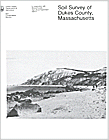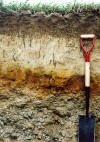The following map unit description is from the published "Soil Survey of Dukes County, Massachusetts"


Soil Survey of
Dukes County Massachusetts
The following map unit description is from the published "Soil
Survey of Dukes County, Massachusetts"


HaA-Haven very fine sandy loam, 0 to 3 percent slopes. This soil is very deep, nearly level, and well drained. It is in broad areas on outwash plains mostly in the central and southern parts of Martha's Vineyard. The areas of this soil are irregular in shape and range from 4 to 300 acres. They make up nearly 4 percent of the survey area.
Typically, the surface layer is dark brown very fine sandy loam about 2 inches thick. The subsoil is dark yellowish brown, yellowish brown, and light olive brown very fine sandy loam 21 inches thick. The substratum is stratified yellowish brown, yellowish red, and brownish yellow coarse sand to a depth of 60 inches or more.
Included with this soil in mapping are small areas of Carver, Riverhead, and Tisbury soils. Also included are small areas of soils that have slopes of 3 to 8 percent. The included areas make up about 20 percent of the map unit.
The permeability of this Haven soil is moderate in the subsoil and very rapid in the substratum. Available water capacity is moderate. The depth to the seasonal high water table is more than 6 feet.
Most areas of this soil are in woodland. Some areas are in cropland, and a few areas are used for homesites.
This soil is well suited to cultivated crops and to hay and pasture. Incorporating crop residue into the soil and adding manure to the surface layer increase the organic matter content of the soil and improve tilth. The main pasture management concern is the prevention of overgrazing, which reduces the density and hardiness of plants. The use of proper stocking rates, restricted grazing during wet periods, and rotational grazing help to maintain pastures and reduce soil compaction.
This soil is well suited to woodland productivity. Removal or control of competing vegetation will help to attain optimum growth of seedlings. The common trees on this soil are white oak, eastern white pine, scarlet oak, black oak, and red pine.
This soil is in capability class I.
HaB-Haven very fine sandy loam, 3 to 8 percent slopes. This soil is very deep, gently sloping, and well drained. It is in broad areas and on small hills mostly in the central and southern parts of Martha's Vineyard. The areas are irregular in shape and range from 4 to 300 acres. They make up less than 1 percent of the survey area.
Typically, the surface layer is dark brown very fine sandy loam about 2 inches thick. The subsoil is dark yellowish brown, yellowish brown, and light olive brown very fine sandy loam 21 inches thick. The substratum is stratified yellowish brown, yellowish red, and brownish yellow coarse sand to a depth of 60 inches or more.
Included with this soil in mapping are small areas of Carver, Riverhead, and Tisbury soils. Also included are a few areas of soils with slopes of 0 to 3 percent and 8 to 15 percent. Included areas make up about 25 percent of this unit.
The permeability of this Haven soil is moderate in the subsoil and very rapid in the substratum. Available water capacity is moderate. The depth to the seasonal high water table is more than 6 feet.
Most areas of this soil are in woodland. Some areas are in cropland, and a few areas are used as homesites.
This soil is well suited to cultivated crops and to hay and pasture (fig. 10). Conservation tillage and the use of cover crops and grasses and legumes in the cropping system help to control an erosion hazard, improve tilth, and increase the organic matter content of the soil. The main pasture management concern is the prevention of overgrazing, which reduces the density and hardiness of plants. The use of proper stocking rates, restricted grazing during wet periods, and rotational grazing help to maintain pastures and reduce soil compaction.
This soil is well suited to woodland productivity. Removal or control of competing vegetation will help to attain optimum growth of seedlings. The common trees on this soil are white oak, eastern white pine, scarlet oak, black oak, and red pine.
This soil is generally suitable as a building site. The soil in some areas does not adequately filter the effluent from septic tank absorption fields, causing a hazard of pollution to ground water. Low density housing reduces the volume of effluent, thus lessening the pollution hazard.
This soil is in capability subclass IIe.